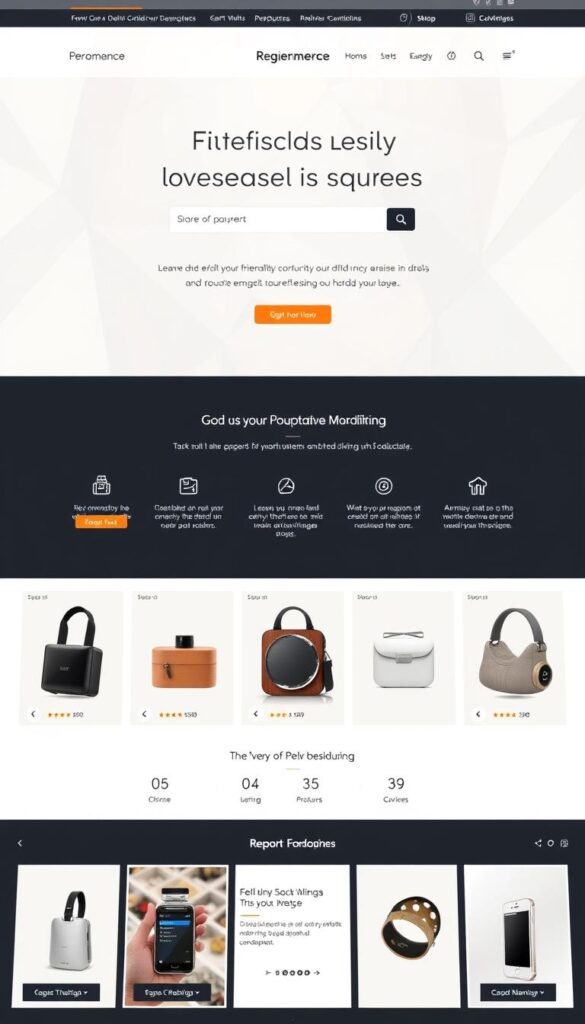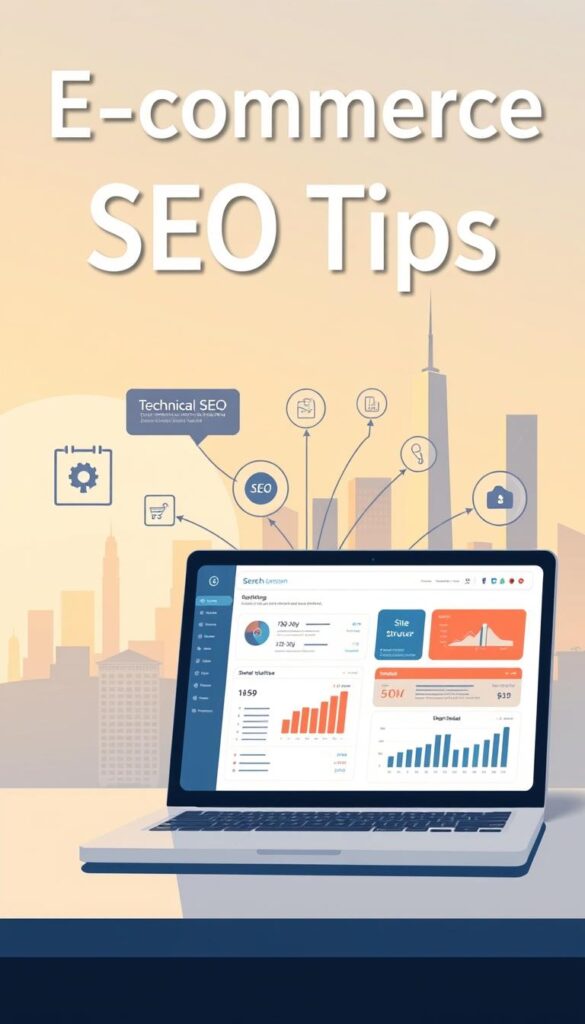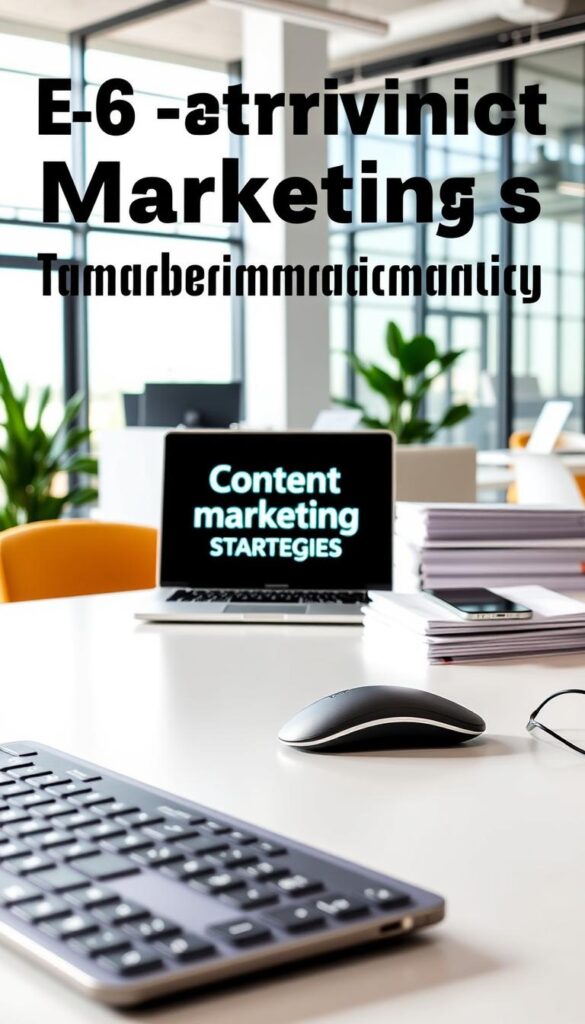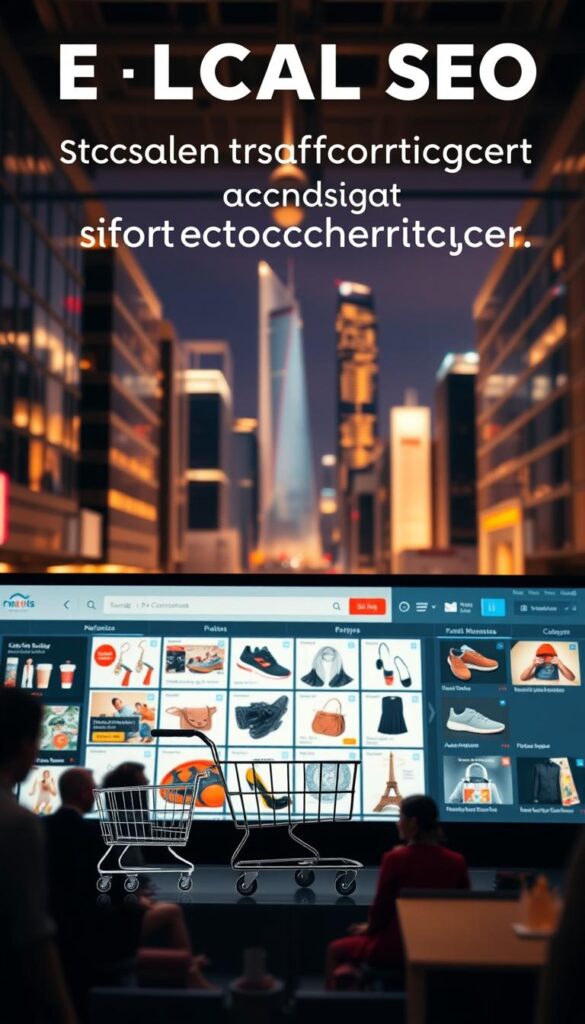Boost E-commerce Sales with Our SEO for E-commerce Websites
The online shopping world is getting more crowded. Over 3.9 million users are expected to shop online in the next 5 years. To keep up, e-commerce sites need to improve their online presence and sales. One key way is to make their websites search engine friendly.
Recent studies have shown that e-commerce websites with effective SEO strategies experience significant increases in sales and customer engagement. By using SEO, businesses can make their site more visible. This attracts more people who are likely to buy, leading to more sales.
Key Takeaways
- Effective SEO strategies can significantly increase e-commerce sales.
- Over 3.9 million users are expected to shop online in the next 5 years.
- SEO enhances website visibility and attracts targeted traffic.
- E-commerce businesses must optimize their websites for search engines.
- Improved online presence drives customer engagement and sales.
Understanding the Importance of SEO for E-commerce
Online shopping has grown a lot, making SEO key for e-commerce success. More people use the internet to find what they need. So, having a strong e-commerce SEO plan is essential to stay ahead.
Now, 58.3% of website visits come from mobile devices. This shows how important it is to make e-commerce sites work well on phones. It helps improve visibility, bring in more visitors, and make the site easier to use.
What is E-commerce SEO?
E-commerce SEO means making an online store’s site better for search engines. This includes using the right keywords, optimizing the site itself, and getting more links. The goal is to get more people to visit the site.
To do well in e-commerce SEO, you need to know how search engines work. You also have to keep up with their changes. By making product and category pages better, e-commerce sites can get more visitors and customers.
Benefits of SEO for Online Stores
SEO for online stores has many benefits. Some key ones are:
- Being more visible in search results
- Getting more targeted traffic
- Building trust in the brand
- Keeping traffic coming over time
- Being cheaper than paid ads
These advantages help e-commerce sites sell more and make more money. They do this without the high costs of paid ads.
Why Choose SEO Over Paid Advertising?
SEO gives long-term benefits, unlike paid ads that stop working when the money runs out. A good SEO plan keeps bringing visitors to a site for a long time.
“SEO is a long-term strategy that can drive sustained traffic and sales, making it a valuable investment for e-commerce businesses.”
SEO also builds trust with potential customers. Sites that rank higher in search results are seen as more reliable and trustworthy.
Keyword Research for E-commerce Success
Keyword research is key for e-commerce sites. It helps find and use the right search terms. This way, online stores can match what customers are looking for. This improves their ranking and brings in more visitors.
Identifying Relevant Keywords
Finding the right keywords starts with knowing what your audience searches for. You need to brainstorm, look at what competitors do, and use tools for research. Relevant keywords have a lot of searches, are not too hard to rank for, and match what you sell.
Start by making a list of main terms for your products. Then, add synonyms, related terms, and long-tail keywords. These are what people might use when searching.
Tools for Effective Keyword Research
Many tools help with keyword research. Google Keyword Planner, Ahrefs, SEMrush, and Moz Keyword Explorer are some of them. They show how often people search for things, how competitive they are, and related keywords. This helps us make a better plan for keywords.
- Google Keyword Planner: Good for finding keywords and seeing how often they’re searched.
- Ahrefs: Has lots of keyword research features, including looking at what competitors do.
- SEMrush: Does SEO checks and gives insights on keywords.
Using these tools helps us create a strong keyword plan. This plan brings more people to our e-commerce site.
Long-Tail Keywords and Their Impact
Long-tail keywords are specific phrases with lower search numbers but are less competitive. For example, “women’s size 8 running shoes” is more specific than “running shoes.”
Targeting long-tail keywords helps e-commerce sites a lot. These keywords show people are ready to buy. By using them in our listings and content, we get more people interested in buying.

In summary, good keyword research is essential for e-commerce SEO. By finding the right keywords, using the right tools, and focusing on long-tail keywords, e-commerce sites can rank better, get more visitors, and sell more.
On-Page SEO Strategies
To stand out in the competitive e-commerce world, using effective on-page SEO is key. On-page SEO makes your website better for search engines and users.
Optimizing Product Descriptions
Product descriptions are vital for e-commerce SEO. Well-crafted descriptions tell customers about the product and help search engines index it. To make product descriptions better:
- Use unique and descriptive content for each product.
- Incorporate relevant keywords naturally.
- Highlight key product features and benefits.
For example, instead of a generic description, talk about the product’s unique features. Like, “This eco-friendly water bottle is made from durable, BPA-free materials and keeps drinks hot for up to 24 hours.”
Importance of Title Tags and Meta Descriptions
Title tags and meta descriptions are key for search engine results pages (SERPs). They give a quick summary of your page’s content and encourage clicks.
| Element | Purpose | Best Practices |
|---|---|---|
| Title Tags | Defines the title of a page | Include primary keyword, be descriptive, and limit to 60 characters |
| Meta Descriptions | Summarizes the page’s content | Entice users, include secondary keywords, and limit to 160 characters |
Utilizing Headers for SEO Benefits
Headers (H1, H2, H3, etc.) make your content easier to read and understand. Proper header usage boosts your page’s readability and SEO.
To use headers well:
- Use H1 tags for the main title of the page.
- Organize content with H2 and H3 tags for subheadings.
- Ensure headers are descriptive and include relevant keywords.

By using these on-page SEO strategies, e-commerce sites can rank better, get more traffic, and increase sales.
Technical SEO for E-commerce Websites
The technical SEO world for e-commerce is complex. It includes site speed, mobile-friendliness, and structured data. Understanding these areas is key to improving your online store’s visibility and user experience.
Site Speed and Its Importance
Site speed is crucial for both users and search engines. A slow site can cause people to leave quickly and buy less. Optimizing site speed means compressing images, using browser caching, and reducing CSS and JavaScript files.
Google PageSpeed Insights is a great tool for improving site speed. It offers tips to make your site load faster. Faster sites keep users engaged and can rank higher in search engines.

Mobile Optimization Strategies
Most online shoppers use mobile devices. So, mobile optimization is essential. A mobile-friendly site works well on all devices, giving users a smooth experience.
Key strategies include responsive design, optimizing images for mobile, and making content easy to read on small screens. By focusing on mobile, e-commerce sites can reach more people and rank better in search engines.
Structured Data and Rich Snippets
Structured data helps search engines understand your web pages. It lets them create rich snippets in search results. Rich snippets can show product reviews, prices, and availability, making your listings more appealing and informative.
To use structured data, add schema markup to your product pages. This gives search engines detailed product information. It can make your site more visible in search results and attract more visitors.
By improving technical SEO like site speed, mobile optimization, and structured data, e-commerce sites can boost their online presence. This attracts more customers.
Building a User-Friendly E-commerce Site
A good e-commerce site is key to success. It must be easy to use. This makes customers happy and helps sell more.
A well-made site draws in more visitors. It keeps them coming back with a smooth shopping journey. To make this happen, we need to focus on a few important things.
Simplifying Navigation for Better UX
Easy navigation is crucial. It lets customers find what they need quickly. A messy menu can frustrate them and cost sales.
- Use clear and concise labels for categories and subcategories.
- Implement a search function that provides relevant results.
- Ensure that the navigation menu is consistent across all pages.
By making navigation simple, we improve the user experience. This makes customers more likely to come back.
Importance of Internal Linking
Internal linking helps customers find more products or content. It also helps search engines understand our site.
Effective internal linking strategies include:
- Linking to relevant products or categories from product descriptions.
- Using anchor text that is descriptive and relevant.
- Avoiding over-linking, which can be overwhelming for users.
SEO experts say internal linking is great for both users and search engines. Here’s a look at good vs. bad practices:
| Good Practices | Bad Practices |
|---|---|
| Linking to relevant and related content | Linking to irrelevant or unrelated content |
| Using descriptive anchor text | Using generic anchor text like “Click here” |
| Limiting the number of links per page | Overwhelming users with too many links |
Enhancing Visual Content with Alt Text
Visual content is important for any e-commerce site. But we must optimize it for search engines and accessibility. Alt text for images is a key step.
Alt text serves two main purposes:
- It provides a description of the image for visually impaired users using screen readers.
- It helps search engines understand the content of the image, improving our site’s SEO.
Write alt text that is descriptive and concise. Include target keywords when it makes sense. For example, 
“The use of alt text not only improves accessibility but also enhances our site’s visibility in image search results.”
By focusing on these areas, we can make a user-friendly e-commerce site. It attracts customers and gives them a great shopping experience. This drives sales and growth.
Content Marketing for E-commerce SEO
E-commerce businesses can greatly benefit from content marketing. It helps improve product visibility, drive more traffic, and engage customers better.
Blogging for Product Visibility
Blogging is a key tool for e-commerce sites. It lets them show off products in detail and in an interesting way. By writing informative blog posts, businesses can increase product visibility and draw in potential customers. It’s best to focus on topics that match your products and audience.
For example, a fashion e-commerce site can write about styling tips, trends, and fabric care. This not only highlights products but also makes the brand seem like an expert in the field.
Leveraging User-Generated Content
User-generated content (UGC) is a great strategy for e-commerce sites. UGC includes customer reviews, testimonials, and social media posts about products. By leveraging UGC, businesses can gain trust with potential customers and boost their credibility.
To get more UGC, e-commerce sites can use review systems, run social media contests, or offer rewards for sharing product experiences.
Creating How-To Guides and Tutorials
How-to guides and tutorials are great for engaging audiences and boosting SEO. By making detailed guides on product use or problem-solving, businesses can attract and keep customers.
For instance, a tech e-commerce site can make tutorials on setting up and using electronic devices. This kind of content adds value to the customer’s experience and can improve search engine rankings.

By using these content marketing strategies, e-commerce businesses can get better search rankings, more traffic, and higher sales.
Local SEO Strategies for E-commerce
E-commerce businesses can boost their local search presence with smart local SEO tactics. As digital trends change, online stores with physical locations must focus on local SEO. This helps attract local customers and stay competitive.
Targeting Local Customers Effectively
To reach local customers, we must understand their search habits. We should optimize our website content with keywords that local users search for. This makes our site more visible to them.
It’s also important to make our website mobile-friendly. Many people search for local businesses on their phones. A mobile-friendly site improves user experience and boosts sales chances.
Optimizing Google My Business
Google My Business (GMB) is a key tool for local SEO. By claiming and optimizing our GMB listing, we boost our local search visibility. We can share important business details like address, hours, and contact info.
To optimize our GMB listing, we must keep our business info current and accurate. Also, responding quickly to customer reviews is crucial.
Local Listings and Citations
Local listings and citations mention our business details on other websites. Consistency is key here. Inconsistencies can confuse search engines and hurt our local rankings.
| Directory | Description | Importance |
|---|---|---|
| Google My Business | Essential for local SEO, provides business information to Google users. | High |
| Yelp | Popular review site that can impact local search visibility. | Medium |
| Local Online Directories | Other directories like Bing Places, Apple Maps, and industry-specific listings. | Medium to High |
By using these local SEO strategies, e-commerce businesses can get more visibility in local searches. This attracts more local customers and boosts sales.

Link Building Techniques
In the world of e-commerce, link building is key to success. It’s about getting high-quality backlinks from the right places. This can really help your site rank better and get more visitors.
Importance of Backlinks
Backlinks are like votes of confidence for search engines. They show that your content is worth sharing. The best backlinks come from sites that are both authoritative and relevant.
- Enhance credibility and trustworthiness
- Improve search engine rankings
- Drive referral traffic
Finding Relevant Link Building Opportunities
To get the most out of link building, look for opportunities in your niche. Here are a few ways to do it:
- Guest blog on sites in your industry
- Make content like infographics or guides that people want to share
- Join in on industry forums and discussions
Engaging with Influencers for Links
Working with influencers can be a great way to get links. By teaming up with influencers, you can reach their followers and get quality backlinks.
It’s important to build real relationships and offer value when working with influencers.

Using these link building methods can help your e-commerce site get more seen online. This can lead to more visitors and higher sales. A steady and smart link building plan is key to lasting success in SEO for e-commerce websites.
Measuring E-commerce SEO Success
To see how well our e-commerce SEO works, we need to look at important metrics. We track key metrics, use tools to watch our SEO, and change our plans based on what we learn.
Key Performance Indicators
It’s key to watch the right numbers to see how our SEO efforts are doing. Some important metrics include:
- Organic Traffic: How many people visit our site from search results.
- Conversion Rate: The percent of visitors who do what we want, like buying something.
- Keyword Rankings: Where we rank for important keywords in search results.
- Bounce Rate: The percent of visitors who leave without doing anything else.
By keeping an eye on these numbers, we learn a lot about our SEO and find ways to get better.
Tools for Monitoring SEO Performance
To keep track of our SEO, we need the right tools. Some top tools are:
- Google Analytics: Gives us deep insights into our site’s traffic, how well it converts, and what users do.
- SEMrush: Does SEO audits, tracks keywords, and compares us to competitors.
- Ahrefs: Watches our backlinks, keyword rankings, and how well our content does.

Adjusting Strategies Based on Data
Good e-commerce SEO isn’t just about starting plans. It’s also about always checking and tweaking them based on what we learn. By looking at our data, we figure out what’s working and what’s not.
If we see some keywords bring a lot of traffic but not many sales, we can change our content and product pages. If our site’s slow and people leave quickly, we can work on making it faster.
“The goal is to turn data into insights, and insights into action.”
By using data to guide our e-commerce SEO, we make sure our plans stay effective and meet our business goals.
Common SEO Mistakes to Avoid
To succeed in e-commerce SEO, it’s key to avoid common mistakes. These mistakes can hurt your online store’s performance. Good SEO strategies for e-commerce go beyond just optimizing product pages. They need a full approach that includes technical SEO, content marketing, and link building.
Overlooking Mobile Compatibility
Most online shoppers use mobile devices. So, making sure your e-commerce site works well on mobile is a must. A site that works well on mobile improves user experience and helps with search engine rankings. Google’s mobile-first indexing means your site’s mobile version is the main one for indexing and ranking.
Ignoring Site Speed Issues
Site speed is very important for both user experience and SEO. Slow sites can cause people to leave quickly and not buy anything. To speed up your site, optimize images, use browser caching, and reduce CSS and JavaScript files.
Failing to Update Content Regularly
Keeping your content fresh is crucial for staying relevant and attracting search engines. This can mean updating product descriptions, adding new blog posts, or refreshing category pages with the latest trends and products.

By avoiding these common SEO mistakes, e-commerce businesses can boost their search engine rankings. This leads to more traffic and higher sales.
Future Trends in E-commerce SEO
The world of e-commerce SEO is always changing. It’s key to keep up with new trends to stay ahead. Key factors include voice search, AI, personalization, and sustainability.
Voice Search: A New Era
Voice assistants are becoming more popular. This changes how people search for things online. To stay competitive, e-commerce sites need to optimize for voice search.
They can do this by using natural language and long-tail keywords. This helps them show up in voice search results.
AI-Driven Personalization
Artificial intelligence is changing SEO for e-commerce. AI helps tailor content and product suggestions to each customer. This makes shopping better for everyone.
By using AI and machine learning, e-commerce sites can get better at SEO. This improves their online presence.
Sustainability in SEO
More people care about the environment, making sustainability important in SEO. Businesses that focus on being green stand out. They attract customers who care about the planet.
By showing they care about the environment, e-commerce sites can boost their reputation. This is good for business.
FAQ
What is e-commerce SEO, and why is it important for online stores?
E-commerce SEO helps online stores rank higher in search results. It drives more sales by improving rankings and attracting targeted traffic. This boosts sales and revenue over time.
How do I conduct keyword research for my e-commerce website?
Start by finding relevant keywords. Use tools like Google Keyword Planner, Ahrefs, or SEMrush. Analyze long-tail keywords to target the right audience.
What are some effective on-page SEO strategies for e-commerce websites?
Improve product descriptions and use effective title tags and meta descriptions. Use headers to structure content and highlight key points. These strategies boost rankings and drive more traffic.
How can I improve my e-commerce website’s technical SEO?
Focus on site speed and mobile optimization. Use structured data for rich snippets. These steps improve rankings, drive traffic, and enhance user experience.
What is the role of content marketing in e-commerce SEO?
Content marketing boosts rankings, drives sales, and enhances user experience. Blog for product visibility, use user-generated content, and create guides and tutorials.
How can I optimize my e-commerce website for local search?
Target local customers and optimize your Google My Business listing. Manage local listings and citations. These strategies improve local visibility and attract more local customers.
What are some effective link building techniques for e-commerce websites?
Get high-quality backlinks and find relevant link building opportunities. Engage with influencers to get links. These strategies improve rankings and drive traffic.
How do I measure the success of my e-commerce SEO efforts?
Track key metrics and use tools to monitor SEO performance. Adjust strategies based on data insights. This improves rankings and drives sales.
What are some common SEO mistakes that e-commerce businesses should avoid?
Don’t overlook mobile compatibility, ignore site speed issues, and fail to update content regularly. Avoiding these mistakes boosts rankings and drives sales.
What are the future trends in e-commerce SEO that I should be aware of?
Watch for the rise of voice search, AI, and personalization in SEO. Also, consider sustainability. Understanding these trends helps you stay competitive.
How can I improve my e-commerce website’s user experience?
Simplify navigation, use internal linking, and optimize visual content. A seamless user experience improves satisfaction and drives sales.
What are the benefits of using SEO over paid advertising for my e-commerce website?
SEO offers long-term results and improves rankings. It drives targeted traffic, making it a better choice than paid advertising for many stores. Understanding SEO benefits helps in making marketing decisions.
The post Boost E-commerce Sales with Our SEO for E-commerce Websites first appeared on ItsAndroidzilla.
source https://itsandroidzilla.com/android/boost-e-commerce-sales-with-our-seo-for-e-commerce-websites/
Comments
Post a Comment